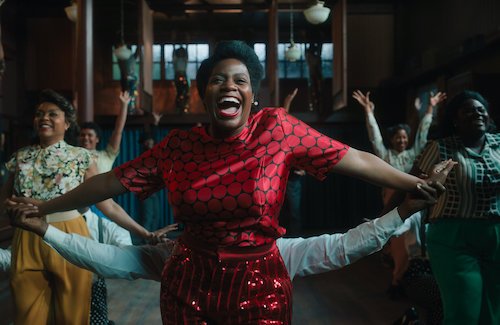The Color Purple (2023)
Written by Andreas Babiolakis
Why create another adaptation of Alice Walker’s adored novel, The Color Purple? We’ve had Steven Spielberg’s 1985 award-winning film and the stage musical version. Did we need another? Director Blitz Bazawule — known for co-directing the visual accompaniment to Beyoncé’s album The Lion King: The Gift, known as Black Is King — has made his claim that, yes, another version of The Color Purple was necessary, and it’s easy to see how strongly he felt about proving it. His take combines the cinematic take of 1985 and the musical nature of the stage adaptation (while culling quite a few numbers amongst other changes) so it feels authentically his own, which is reason enough to at least consider watching this version. The entire film has a pulse; even though it consists of more than just musical numbers, it still feels like a two-hour-twenty-minute music video that never seems dull. There are many strong decisions here, like the constant use of yellows, beiges, and other bright, pale colours to allow the seldom uses of that titular purple to truly pop whenever it graces the screen (indicative of the hints at joy and purpose that keep you living). While not a dark film overall, there are moments of raw grit that punctuate how awful some moments are (not every bubbly musical has to sugarcoat serious issues). Daydreaming becomes a reason to turn the film into a lavish production of the highest order. Yes. A lot of this latest take on The Color Purple works.
We start in the early 1900s in Georgia. Celie (Fantasia Barrino, with Phylicia Pearl Mpasi as a young Celie) has endured a childhood of abuse from her awful father: the same father who forces her to marry another problematic man named Albert “Mister” Johnson (Colman Domingo). Mister beats Celie frequently and forces her to cook and clean exactly how he wants. She becomes estranged from her sister Nettie (Halle Bailey), who leaves their father and is subsequently threatened to leave by Mister (because she rejected his advances). The Color Purple leaps through the decades rather quickly, as Celie grows up under Mister’s boot and with zero life experience; she continues to be separated from Nettie, whose whereabouts and health are a complete mystery to her (Mister ensures that all contact is cut off). She befriends Sofia (Danielle Brooks): the partner of Mister’s son, Harpo (Corey Hawkins). Celie will eventually become acquainted with musician Shug (Taraji P. Henson), whom Mister adores (ensuring to Celie that he made a mistake in not marrying her. Ouch). Together, Celie, Sofia, and Shug have their own tribulations that they conquer because of the faith they give one another. Celie becomes stronger as The Color Purple continues. In order to find Nettie, she has to first save herself.
Fantasia Barrino soars as Celie in The Color Purple via a heartbreaking, triumphant performance.
The depictions of domestic violence and the insistence to rise above abusers are well-handled in this film. I could feel the weight of what was transpiring on screen — be it the cyclical, generational plague of misogyny, or the release of music and joy amidst turmoil — for the majority of the runtime. My biggest problem with The Color Purple is that it got maybe too ambitious to the point that not every plot element felt organic or concluded sufficiently. A big example is in the form of a subplot involving Sofia and her being forced to be a maid (but really, a slave) to the wife of the Georgian mayor. This storyline starts suddenly yet strongly, and yet its conclusion — which can be felt in the change to Sofia’s personality throughout the third act of The Color Purple — still feels shockingly absent. This is clearly a big deal and I don’t think the story does the character or Brooks’ performance justice. The same can be said with Mister’s change of heart later on in the film: a swift turnaround by a character who has been a monster for two cinematic hours. I know The Color Purple is already quite long, but I wish some of the narrative elements were ironed out a bit better, especially since the film already takes its time to develop other storylines and add dimension to the characters on screen.
I could do a roll call and point out every great performance here, from Colman Domingo’s harrowing Mister to Danielle Brooks’ two sides of Sofia’s coin (her sassy, coruscating character, and the depressing solemness of when she is broken), but we’ll be here all day; trust me when I say that everyone here is great (including surprise cameos from Whoopi Goldberg — who was in the 1985 film — and singer Ciara). I want to prioritize giving flowers to Fantasia Barrino who absolutely broke my heart throughout this film as Celie. You forget right away that she is unrecognizable in this role as you get swept away and crushed by the agony that she feels frequently, the mysteries of life she wishes to explore, and all of her dreams she can feel rotting away. Even when the film itself would get flimsy, Barrino’s performance was a constant force of brilliance. I know that musicals are her forte, but — seeing as this is her cinematic acting debut — I cannot help but wonder what she would be like in a serious drama, or a knee-slapping comedy. Twenty years after her American Idol victory, there is still clearly more to the singer than meets the eye. I don’t want this to be the sole time I see her in a film: I just know she has a well of feature films waiting for her to grace.
Sure, The Color Purple may get ahead of itself at times, but the majority of this film is strong. The musical numbers — as a whole — are the best of 2023. The choreography and production help make these storytelling lyrics come alive with vibrancy. Even the story — at times— is thorough enough that you understand most characters on a very deep level. If you are into musicals, this film does the trick without question. I still wanted a bit more narratively, but we do get our money’s worth when it comes to the technical and aesthetic side of The Color Purple, and that makes sense when there’s already a feature film that handles the coming-of-age and historically political story. If you want to see this tale as a musical, then that is pretty much what you get here. It won’t act as a replacement for the 1985 film but rather as its own cinematic version with its traits to cherish. Besides, what does work resonated with me more than what doesn’t (like Barrino giving me goosebumps that made me forget about the narrative lapse I was just scratching my head over). The Color Purple is equal parts a celebration and a lesson. Its style, precision, and artistic exuberance will keep you moving past the occasional pitfalls right to the end credits.
Andreas Babiolakis has a Masters degree in Film and Photography Preservation and Collections Management from Ryerson University, as well as a Bachelors degree in Cinema Studies from York University. His favourite times of year are the Criterion Collection flash sales and the annual Toronto International Film Festival.






